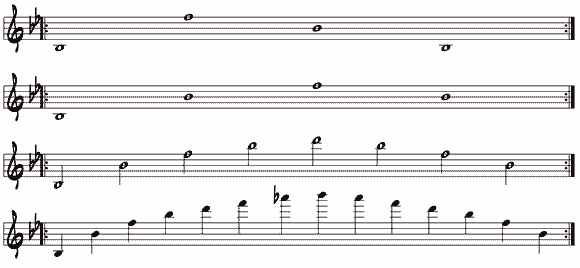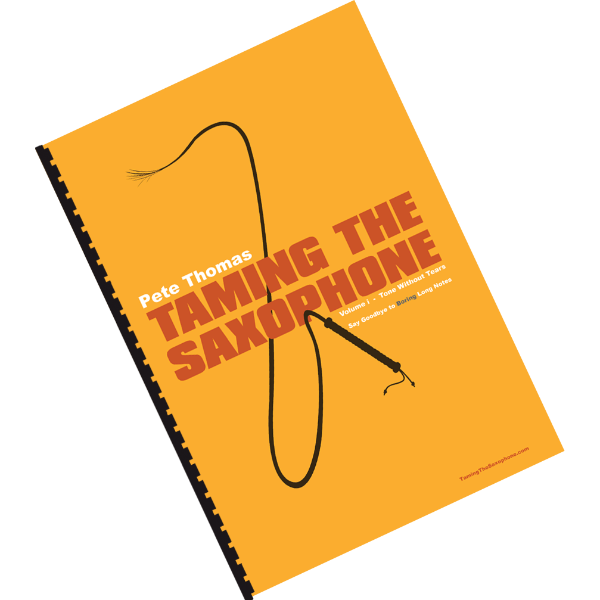Why is practicing overtones so useful?
- In order to play the overtones you need to think about and possible develop a more flexible embouchure. Altering your tongue position and possibly the shape of your oral cavity can help with this.
- You need to be able to imagine the sound of the note before you play it, so for one thing this is very good ear training. Because the fingering remains the same for each note as you play upwards or downwards in the harmonic series, you need to be able to “hear” the pitch in your mind before playing it. Along with the changes to embouchure or oral cavity, some players call this “voicing.” (See below)
- Harmonics are useful for altissimo playing, as well as some effects such as false fingerings.
First Steps
Finger a note in the lower register, then, without moving any fingers or using the octave key, you should be able to adjust your embouchure and breath support to sound various higher notes, these are called the harmonic (or overtone) series consist of the same notes relative to each basic note (fundamental): You should eventually be able to continue through the harmonic series to get at least eight notes (two octaves):

1st overtone = 2nd harmonic
2nd overtone = 3rd harmonic
3rd overtone = 4th harmonic
Harmonics or Overtones?
NB: There is a lot of confusion between the terms harmonics and overtones (or partials). Very simply, the basic note you start from is called the 1st harmonic or fundamental. The next note (ie one octave higher) is called the 2nd harmonic, but the 1st overtone. The next note (octave and a fifth) is the 3rd harmonic but 2nd overtone, and so on…
You may find that the 3rd note of the series (octave and a fifth above the fundamental) is easier to get than the 2nd note (octave above the fundamental). The following exercise is based on the bottom Bb, but should be tried on all notes of the lower register. As you get higher the harmonics become more difficult. You will probably need to alter your embouchure to get the harmonics to sound, experiment with putting more (or less) mouthpiece in your mouth and changing the position of your tongue. Try to imagine the note you are trying to play so that you can hear it in your head.
| Frequency | Order | Name 1 | Name 2 | Name 3 | Wave Representation |
|---|---|---|---|---|---|
| 1 × f = 440 Hz | n = 1 | 1st partial | fundamental | 1st harmonic |  |
| 2 × f = 880 Hz | n = 2 | 2nd partial | 1st overtone | 2nd harmonic |  |
| 3 × f = 1320 Hz | n = 3 | 3rd partial | 2nd overtone | 3rd harmonic |  |
| 4 × f = 1760 Hz | n = 4 | 4th partial | 3rd overtone | 4th harmonic |  |
Wikimedia Commons ©Juan Aguirregabiria
Basic Exercises
This takes a long time to master, but is an extremely useful exercise for general tone but also useful for developing altissimo range and alternate fingerings.

This next exercise is a particularly useful one. It can be adapted to have a wider or narrow range. You could instead use just the fundamental and 1st overtone, or you could include more overtones. This is the one I like to warm up on when practicing harmonics.

The Mysterious Art of Voicing
Some teachers make a big deal out of the oral cavity shape and volume, however there is evidence to suggest that the impact this has on your sound and playing is actually quite minimal. Very often a change in oral cavity by either moving tongue position or puffing out your cheeks will inevitably cause slight changes in your embouchure at the “business end,” ie your lips and reed. So it may well be the subtle change here is what causes any change in sound.
You can test this by puffing out your cheeks a lot while concentrating on keeping your embouchure the same. A skilled player will notice no significant difference.
This may be quite a controversial opinion, and is partly based on years of experience and partly based on the acoustic research carried out by Dr. Edward Pillinger. However I believe that there is one small part of the oral cavity than can have an effect in helping to voice overtones. This is the area just behind the top teeth and a very slight alteration, possibly with the aid of tongue articulation and position can help switch between overtones.
